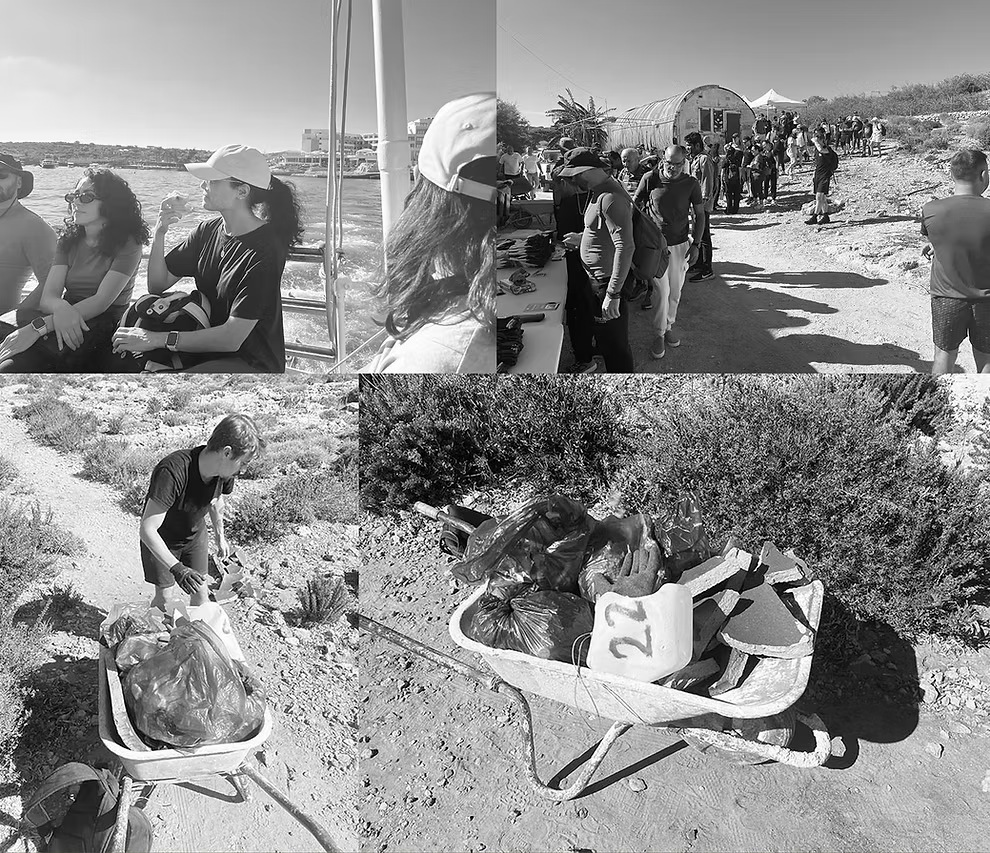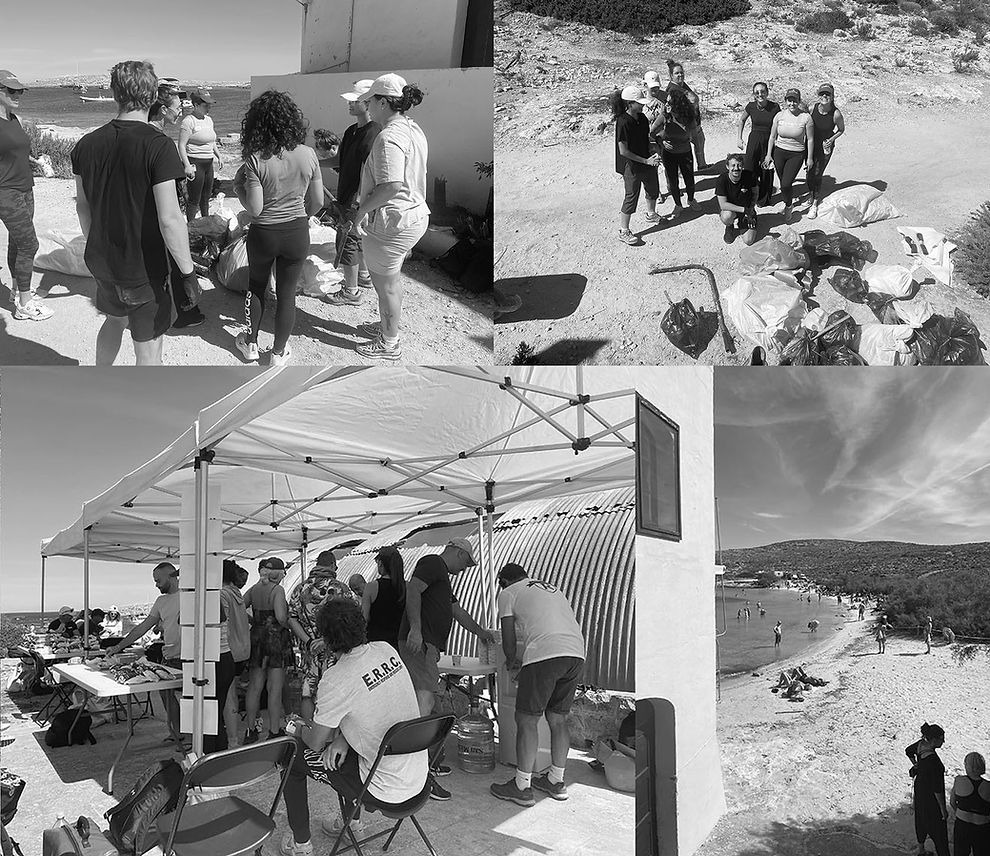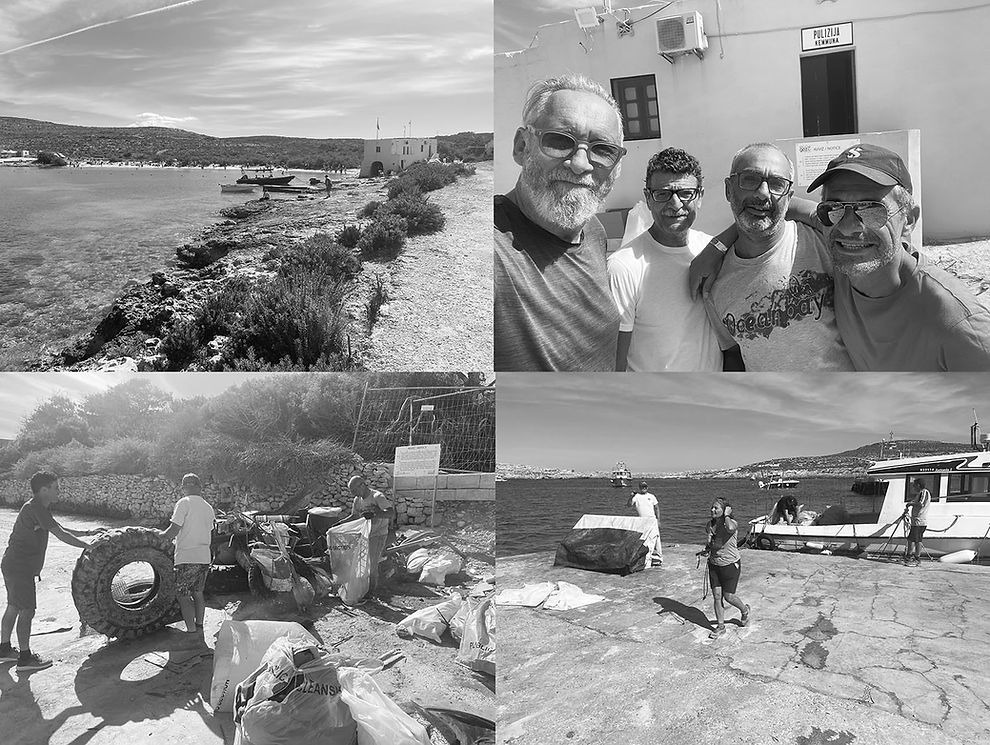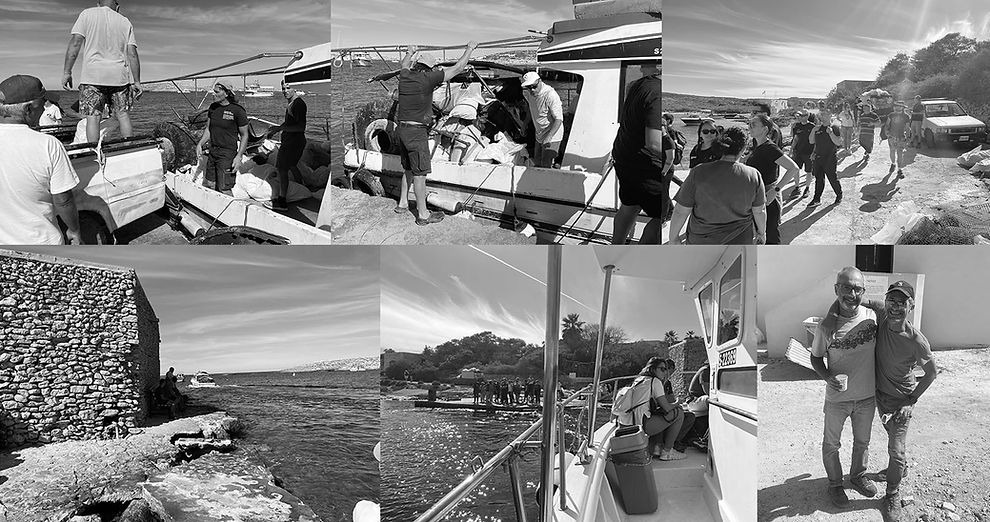On October 9th, I joined an environmental cleanup on the small but iconic island of Comino, with its world-famous Blue Lagoon, nestled between Gozo and Malta.

1. On the boat from Marfa Jetty. 2. Assembling for the team tasks. 3. Team 5 removing heavy objects from the garigue. 4. Too heavy for the wheelbarrow to manage.
The organisers of the cleanup are old friends – divers Raniero Borg, Graziella Buttigieg and brothers Edward and Adrian Sultana – a team I have collaborated with many times in the past, and together we have removed countless tons of marine and other debris from Malta’s sensitive and threatened coastal environment. When they contacted me to see if I was interested in leading a team for this latest event, I didn’t hesitate for a second…
A vulnerable beauty spot
Comino is particularly vulnerable, due to the large numbers of tourists who visit daily, plus an historical lack of care and maintenance of this remote beauty spot. Last year we removed 2.5 tons of broken glass, tires, scrap metal, plastic and other waste from the island, and this year we removed even more. A lot of this was deposited during decades of commercial exploitation and neglect, but some is the result of more recent unchecked tourism and unsupervised recreational activities, such as camping.
The dive team were on site at dawn, to scout out the seabed and tag the location of submerged debris. The majority of the volunteers arrived in two boats at 09:30, divided into five teams, and each assigned a specific area.

1 & 2. Team 5 with the results of our efforts. 3. The emergency services and refreshment station. 4. Holidaymakers enjoying the beach, oblivious to the work going on around them.
Each team was given a number of tasks to carry out – to document their finds and photograph the collected waste, marking the locations for the ground crew to collect by truck – and after a quick breakfast it was time to begin.
Three focus areas
I divided my team into three groups; one was to comb the area between the jetty and the old police station for broken glass, plastic and fragments of old clay water pipes, which were strewn all over the area.
The second group patrolled the open ground between the sand dunes and the boundary wall. We had to be particularly careful not to damage the protected dune ecosystem, and only one person was allowed to step over the boundary ropes to retrieve rubbish.
I lead the third group to the far side of the bay to the slipway, where some large objects – including part of a boat engine left on the beach, and more water pipe fragments strewn up a culvert – had been spotted.
The beach was full of tourists enjoying the sun and swimming in the turquoise waters of the bay, no doubt wondering about the activity going on all around them. The sun was climbing in the sky as we worked – there was a slight breeze which helped to keep temperatures bearable, but even so, the hard physical work and the relentless sun were taking a toll.
At 13:30 it was finally time for lunch, under a tent set up for the purpose. On site were two members of the Emergency Response and Rescue Corps (ERRC) who were there to give first aid, but happily the only injuries they had to deal with were a sprained shoulder and a small flesh wound.

1. The view from the quayside towards the beach. 2. Glen with Raniero, Adrian and Edward (event organisers). 3. Sorting the spoils before bagging. 4. Graziella with her injured shoulder.
Down at the jetty, the divers were bringing in the recovered seabed debris, including a number of massive tractor tires, and stacking them on the quayside, and the ground crew were also busy bringing in the heavy sacks of rubbish from the outlying zones. All of the collected rubbish was eventually piled up on the quay for sorting, and our ground crew were soon busy filling the boat which would transport it across the Gozo channel to the Maltese mainland.
At 15:00 all of the volunteers gathered on the quayside for a group drone photo, before the boats arrived to transport everyone back to Marfa jetty.
Reflecting on the day, I can truthfully say that I still have a deep personal commitment to the environment and will naturally continue to commit my time and energy to these vital cleanup events, but I also have a growing sense of frustration at the shortsightedness of the authorities charged with the care and maintenance of Malta’s remaining open spaces.

1 & 2. Loading the skip boat. 3. Volunteers gathering on the quayside for the drone group shot. 4. The skip boat departs. 6. Adrian and Edward celebrate another great cleanup.
Comino’s arid beauty is extraordinary, but it’s also incredibly vulnerable – and there are many other locations just like it across the Maltese islands. Until personal responsibility becomes second nature – for tourists, locals, and authorities alike – these mass cleanups will remain essential.
The fact that private businesses are stepping up to take action is a hugely positive development, and involving their employees in such efforts is one of the best forms of team-building there is, as we know very well from our own work in this area. But business and private individuals can only do so much – what is missing is a serious plan of action from the government to tackle this growing problem at a national level.





